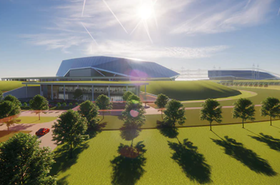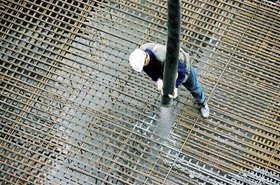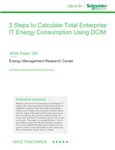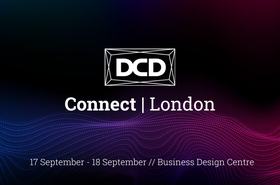As we roll into our third year in the pandemic with Omicron raging around the world, it’s time to stop celebrating the wins and mourning the losses from my 2021 data center and tech predictions and move on to 2022. Whether it’s Covid-brain from my brief and mildly symptomatic tussle with the beast over the holidays, or some other reason, my crystal ball is pretty cloudy and hard to read.
So, let’s mask up and see what this year will have in store for us in the data center and tech world
1 Nuclear power makes headway as carbon-free power option
I may be a bit early on this one, but nuclear power is one of the very few carbon-free options we have that can handle large base loads and doesn’t have issues with intermittency. Yes, it has an image problem as Peter Judge points out in his excellent post from November of 2021. It also has its drawbacks in the form of nuclear waste that lasts farther into the future than I can imagine. That said, we are running out of time and not making enough progress in reducing our carbon emissions. If we can’t start to mitigate the catastrophic issues that we face now and over the next few decades, what will be left in a thousand years when the nuclear waste finally begins to decay?
I am not talking about your father’s (or grandfather’s) nuclear power plants. Gone are the days of the multi-gigawatt bespoke designs of the past that consistently doubled their initial price and schedule. Nuclear is taking the modular approach that has become the norm in the data center industry. One example is US-based NuScale Power which offers small modular reactors (SMRs) in 77MW increments offering 99.98 percent reliability over a 60-year lifetime for a single module. NuScale can also boast that they are the first ever SMR to receive design approval from the Nuclear Regulatory Commission. Another leader in the space is British-based Rolls-Royce which offers a 470 MW module that is a fraction of the cost of traditional nuclear.
Am I saying data center operators are going to start buying nuclear power modules and operating them? Heck no, but why not enter into power purchase agreements (PPAs) similar to how renewables are contracted for today? With data center campuses in the 200-300 MW range in development, it’s easy to imagine an appropriately sized plant being installed nearby and avoid all of the inefficiencies of the power grid.
This isn’t going to happen overnight, but it’s going to make headway in 2022.
2 The metaverse will begin to impact data center design
My predictions wouldn’t be complete without something on the metaverse. How can I miss the biggest marketing buzzword in the last 10 years? For many, including myself, it’s hard to define exactly what the metaverse is. The thinking on this prediction is based on my assumption that a great deal of the metaverse will be built on some kind of an AI platform. What platform that is I have no clue, I am not here to solve the problems, just make predictions.
Based on my knowledge of artificial intelligence (AI), which granted is very limited, the clusters are often similar to supercomputers. Supercomputing data centers are rarely designed in the same configurations as more commercial data centers. They often have less redundancy and include their own integrated cooling systems in some cases. How much the metaverse is based in AI likely depends on a company’s role in developing the metaverse.
With the nascent state of the metaverse, this will have more of an impact over time, but I predict we will start to see signs in the form of alternate designs this year.
3 The metaverse will not have an impact on edge computing…yet
Look at that, I managed to slip in another prediction on the metaverse! That should help move my post up the search engine ranks. The metaverse will simply not develop enough this year to have any measurable impact on the edge computing sector. Without a doubt, as the metaverse matures, it will have a massive impact on edge computing. To enhance the user experience, it will have to push content and compute closer to the user.
For more on edge and the metaverse, check out this recent DCD article.
4 5G starts to live up to the hype
In both 2019 and 2020 I predicted that 5G would change our lives, just not in those particular years. I was right in both cases. The thinking was that the version of 5G that was being rolled out was the low band variety rather than the millimeter wavelength. Without getting into a lot of detail, low band covers large areas and penetrates walls, but at only marginally upgraded speeds from 4G, while millimeter wavelength offers much higher speeds over small areas and doesn’t penetrate structures.
I am sure you have all heard ad nauseam of the recent rollout of upgraded 5G and its potential impact on the navigational systems of airliners. This is all due to the turn up of their new C-band/Mid-band 5G. Some are calling this the ‘Goldilocks’ band for its ability to travel long distances, penetrate structures, and deliver faster connections. Although it doesn’t measure up to millimeter wavelength, it can deliver speeds up to 10 times faster.
I believe this substantially upgraded speed will enable many of the technologies that were promised when 5G was first rolled out. It should aid in the advancement of IIoT, as well as edge computing on a much broader scale. So, 2022 is the year that 5G starts to live up to the hype of years ago. Let’s just hope it doesn’t also lead to more zealots attacking the infrastructure thinking that it caused the pandemic.
5 Cryptocurrency miners will be held accountable on energy usage and sources
It’s been well documented that cryptocurrency miners use a lot of energy and are only concerned with the cost of that energy, not whether it’s sustainably sourced. Datacenter Dynamics has documented this behavior by industry giants such as Stronghold, Marathon, and Ameren. It appears that this has not gone unnoticed as a group of eight US lawmakers sent letters to the top cryptocurrency miners inquiring about how much power they consume, how much carbon is emitted as a result, and their plans for future growth.
These letters are a harbinger of things to come. 2022 will bring the beginning of a reckoning for their past behavior of ignoring sustainability in the name of cheap power and profitability. Many industries have learned that if you don’t govern yourself, someone will do it for you. I don’t know if it will get quite that far this year, but the foundation will be laid. I would also guess that these folks are squarely on the radar for Greenpeace and will find themselves in their next annual name and shame report.
6 The metaverse drives broader acceptance of liquid cooling
Boom, metaverse prediction number three! Anyone for some buzzword bingo? In my data center and tech predictions for 2020, I predicted the market for liquid cooling would remain nascent. That will finally start to change this year. With densities rising this is inevitable.
What has changed since then is a broader use of AI chipsets driving densities higher. This will only be accelerated by the drive toward the metaverse. The metaverse will be driven by AI, so densities will inherently continue to rise as the metaverse matures. I believe this will start with the early innovators of the metaverse such as Meta, Apple, Google, and Microsoft who will form the foundation of the metaverse. It won’t be long before data centers will rely solely on liquid cooling.
Whether this takes the form of immersion cooling, liquid to the chip, or some other form I don’t know, but the migration starts this year.
7 Technology helps improve the sustainability of the construction industry
Being a construction guy, I had to make at least one prediction on the industry. Few people know that the building sector, defined as building operations – as well as building materials and construction, is responsible for as much as 39 percent of annual global CO2 emissions. Building materials and construction, also known as embodied carbon, make up 11% of the annual global total. The building sector emissions need to be reduced by half by 2030 to achieve the goals of the 2015 Paris Agreement. We’ve got a lot of work to do.
There are many technologies coming to the forefront that will aid in this goal. One technology that is already on the market is called CarbonCure. Concrete is one of the main offenders in embodied carbon due to its main constituent, cement. Their technology introduces recycled CO2 into concrete at the batch plant where it crystalizes, thereby reducing the amount of cement necessary to achieve the same strength. The concrete not only uses less cement, but it becomes a permanent form of carbon sequestration. Compass Datacenters was an early adopter of this technology.
There are other technologies entering the market all the time with construction technology becoming a hot investment sector. With the proliferation of electric vehicles, more industrial models are entering the market that will be adopted by the construction industry. My prediction is that technology starts helping the construction industry clean up its act in 2022.
Time will tell…
There you have it, the 8th annual edition of my fearless prognostications about the data center and tech world. Lots of acronyms, buzzwords, and hopefully a few accurate predictions. Where has the time gone? I can only claim the COVID time warp for the last couple of years, so maybe I am just getting old. I think I may be out over my skis a bit on a few of these, but time will tell. I am always interested in hearing your thoughts on my predictions, so please comment and/or reach out on LinkedIn or Twitter.







